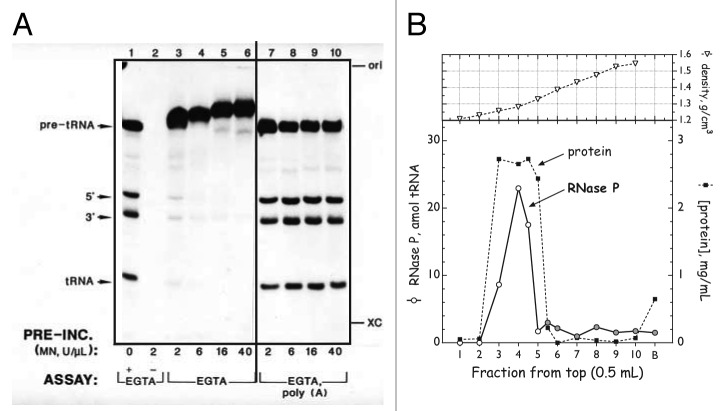Figure 1. Plant RNase Ps do not contain an RNA component. (A) Resistance of spinach chloroplast RNase P to digestion with micrococcal nuclease (MN). Crude enzyme fraction was incubated with the indicated amounts of MN plus 5 mM CaCl2 (30 min at 37°C) after which excess EGTA was added, followed by substrate and reaction buffer. Lane 1, positive control for RNase P (pre-incubated without MN); lane 2, positive control for MN (as lane 1 but MN not inactivated prior to addition of substrate); lanes 3–6, pre-incubated with 2‒40 U MN/μl and treated with EGTA prior to assay; lanes 7–10, as lanes 3–6 with addition of 1 μg poly(A)/μl prior to assay. Modified from reference 44. (Essentially identical results were obtained with wheat nuclear RNase P.48) (B) Buoyant density of spinach chloroplast RNase P.44 Fraction II chloroplast enzyme (~5 mg) was pretreated with MN (1 U/μl, 20 min; terminated with EGTA), brought up to 1.0 ml with gradient buffer, and layered over 4.0 ml of CsCl solution (1.40 g/ml). After centrifugation to equilibrium, fractions were collected from the top and density was determined by refractometry. CsCl was removed by dialysis and fractions were assayed for RNase P. Lower panel, distribution across the gradient of total protein (filled squares) and RNase P activity (open circles: amol mature tRNA formed; shaded circles: non-tRNA-sized material). Upper panel, observed buoyant density of each fraction.

An official website of the United States government
Here's how you know
Official websites use .gov
A
.gov website belongs to an official
government organization in the United States.
Secure .gov websites use HTTPS
A lock (
) or https:// means you've safely
connected to the .gov website. Share sensitive
information only on official, secure websites.
